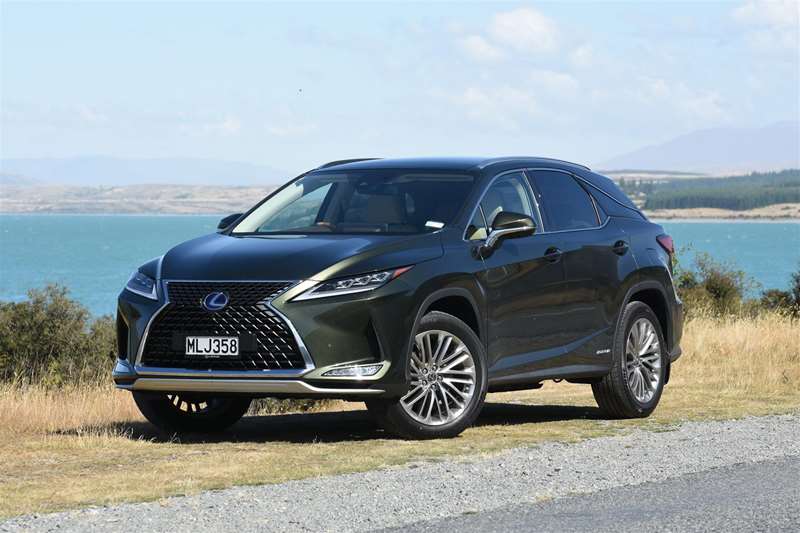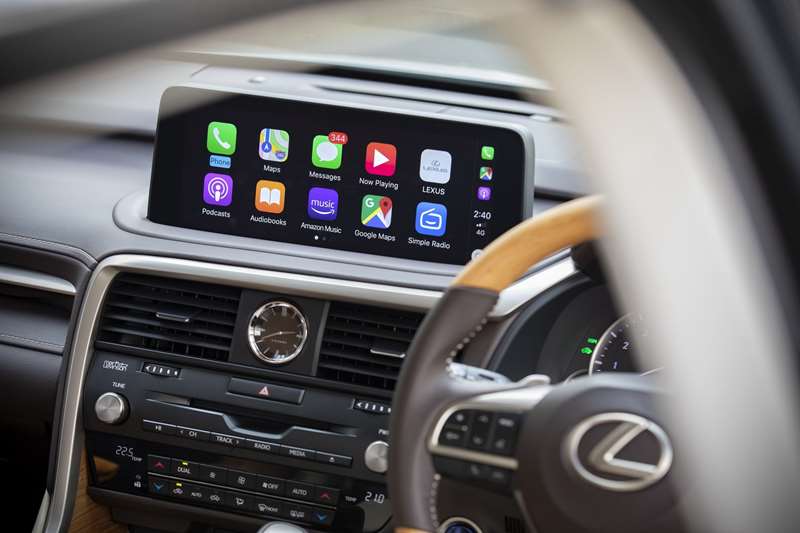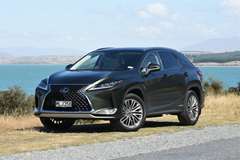David Thomson tries the modified, but not too much, 2020 Lexus models.
What’s New?
The current fourth-generation version of the Lexus RX sport utility has been around since 2015, but it has been updated for 2020.
To use the term ‘‘facelift’’ would, perhaps, be going too far: styling changes are comparatively minor both inside and out. However, there is a substantial upgrade to the standard safety package along with other equipment improvements. These include Apple CarPlay and Android Auto smartphone finally making an appearance on a vehicle carrying the Lexus badge.
As before, a pure petrol V6 or a V6-electric hybrid are the two drivetrains on offer. The pure petrol deploys an eight-speed automatic gearbox to deliver power to all four wheels, while the hybrid utilises an electronically controlled continuously variable transmission.
The two drivetrains are presented in a familiar range of models that starts with the $97,400 RX350 and tops out with the $127,500 extended length seven-seat RX450h.
Both drivetrains featured in this test. First up, with the RX350 in its dynamically enhanced $109,600 F-Sport guise, and then with the $126,900 RX450h in its most luxurious Limited form.
What comes as standard?
Lexus is a luxury brand and the RX is one of its premium vehicles. Its standard equipment levels reflect this.
Features from entry-level include smart-key entry, push-button start, a power-operated tailgate, power-adjusting leather seats, full climate control air-conditioning, Qi wireless phone charging, a surround-sound audio system, satellite navigation, voice command and half-a-dozen USB ports as well as seamless Bluetooth connectivity.
New with this upgrade is touchscreen operability for the 12.3-inch widescreen centre display screen. This feature, along with the equally welcome addition of Android Auto and Apple Car Play integration, means that the fiddly touchpad activation that was previously a bete noire of the RX (and wider Lexus) infotainment experience is no longer a problem.
The same high-level safety specification with full radar cruise control and the like is offered across the range. With the 2020 upgrade, this gains Lane Tracing Assist, Lane Centring and Road Sign Assist and cycle detection systems. The parking radar is improved by a new function that will automatically brake the vehicle during low-speed manoeuvring in response to obstacles including, when reversing, any vehicles detected by the car’s Rear Cross Traffic Alert system.
The RX also features a significant advance in adaptive headlight technology provided on the F-Sport and Limited models.
Called BladeScan, it deploys a dozen LEDs in each headlight. These LEDs automatically switch on and off to provide automated light dipping in response to oncoming traffic. BladeScan has a further special trick — a lens that reflects the LEDs’ computer-controlled light through tiny mirrors that spin 100 times per second to give what Lexus claims are unprecedented levels of clarity.
Opt for the F-Sport, and there are sports-accented front seats (heated and chilled), heated rear seats, 360-degree surround view camera, a colour head-up display, additional sports drive modes, adaptive variable damping and further tweaks for the suspension.
Limited models, too, take the head-up display and surround view camera, and their more softly bolstered front seats are heated and (up front) chilled, too. The Limited also has a full-length panorama roof (partly retractable at the front), extra-plush trim, triple rather than dual zone climate control and a 15-speaker Mark Levinson sound system.
What’s it like to look at?
Distinctive is a term that motoring writers sometimes use for vehicles that don’t do too much to advance the cause of automotive beauty. These vehicles are certainly distinctive when viewed from forward angles.
Aside from the curious styling sweep across the rear pillar (a Lexus RX signature) the rear of the car is more mainstream, and nicely freshened with the 2020 changes.
Of the two vehicles tested, the 350 F-Sport featured more subtle chrome accenting, gained its own distinctive mesh finish for the grille, and a integrated nose spoiler.
Although featuring the same 235/55 R20 tyre package, the 350 F-Sport and 450h Limited differed in the design of their alloy wheels and detail badging.
What’s it like inside?
Both test cars were beautifully finished, but very different in look and feel.
The F-Sport was conservatively padded, with dark charcoal trim, cream contrast stitching and dark uppers. That said, a bolder F-Sport option with red leather is available.
The Limited featured dark chocolate trim mixed with light ivory leather for the seats and elsewhere, and a wood finish on the centre console, door inserts and steering wheel.
There was no shortage of interior practicality on either vehicle.
The power operated tailgate gave access to a boot with 519-litre capacity in pure petrol guise, and 514-litres for the hybrid. The power folding rear seats can be easily stowed to further increase luggage space. Otherwise the rear of the cabin is a roomy and well-appointed area for passengers, with a fold-down centre armrest and a pair of USB ports.
Up front, there is an unusually generous glovebox, a decent centre bin, long pull-out door pockets, and plenty of oddments storage along with bottle and cupholders around the centre console. Two chargeable USB ports nestle at the front of the centre console, and there are two more, along with AUX and 12-volt sockets, located in the centre bin.
Highlights amid the many impressive features of the cabin were the clarity of the centre display screen, excellence of the Limited’s premium sound system, the ability to largely ignore the touchpad thanks to the touchscreen, voice control and smartphone projection.
On the minus side of the ledger, the RX is constantly beeping and chiming at its occupants: it does so when the tailgate is opened, when doors are opened, and in what seems like half a dozen other everyday situations when such alerts are not required. If there is a way to deactivate this “trying to be helpful function” via the RX’s various driver-controllable settings, I couldn’t find it.
What’s it like to drive?
As one might expect, two quite different driving experiences await.
Producing 221kW and 370Nm from its 3.5-litre V6, the RX350 F-Sport impressed for its smooth power delivery and the transition of the engine from aurally muted operation when cruising to a discreet but appealing growl when pushed.
Use of the more aggressive sports drive modes sharpens the F-Sport dynamically without impacting too obviously on ride quality. It doesn’t have nearly the dynamic incision of the best of its European rivals, having less steering feel and more body roll when pushed.
Tipping the scales at around 140kg more than the V6 petrol due to its hybrid powertrain, the 450h is fitted with a CVT rather than a conventional automatic gearbox and, without the F-Sport suspension, has a more comfort-oriented remit. This is further supported by its smooth hybrid system, which combines a modified version of the 350’s V6 engine with a Nickel-Metal battery that powers three separate electric motor generators (one on each front wheel and a single unit for the rear two).
Noting that both are sustained on a diet of 95 Octane petrol, the economy differences between the two are worth pondering. Official Lexus standard cycle figures give the RX450h a 5.7l/100km return on the combined cycle, compared to 9.6l/100km for the RX 350 V6.
I couldn’t replicate those figures or the gap between pure-petrol and hybrid consumption, achieving an 11.2l/100km return for the RX 350, and 8.7/100km for the X450h. The narrower gap between the pair was doubtless due to the high proportion of highway driving; hybrids make their biggest gains over conventional cars during urban driving.
Verdict?
The fact that the RX is New Zealand’s best-selling Lexus model says as much about our love affair with SUVs as it does about the RX’s suitability for the motoring conditions in this country. Perhaps, too, it speaks to a country less enamoured with the pleasures of driving than with luxury and comfort-focused travel.
As a keen driver, the RX 350 F-Sport stirred my motoring soul more than its more luxuriously-appointed hybrid sibling. That said, the smoothness, refinement and features list of the RX 450h holds undeniable appeal and, since comfort is a key part of Lexus DNA, the hybrid does what the RX should do best in the most convincing way.
Photos: Supplied










